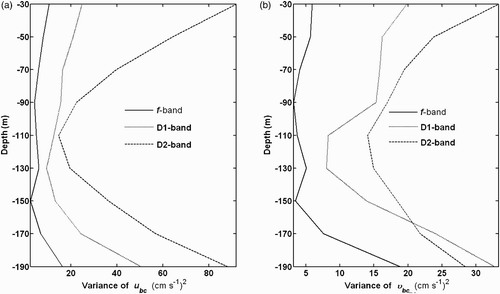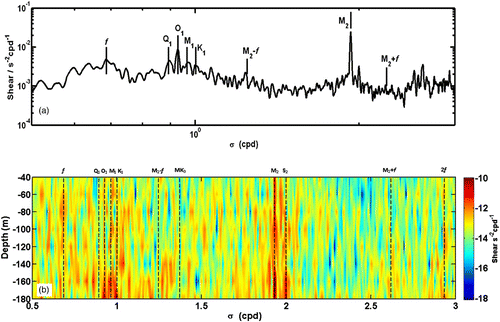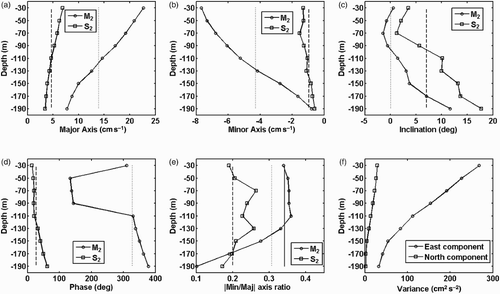Abstract
Acoustic Doppler Current Profiler (ADCP) measurements of the velocity structure in the thermocline in Luzon Strait are presented. The statistics for current, vertical variation of the inertia-gravity waveband, parametric subharmonic instability (PSI), and current shear are analyzed. It was found that 1) barotropic flow primarily consists of a nearly circular mixed tide. Diurnal tides are strongest and show smooth variance with a fortnightly spring-neap cycle, indicative of the astronomical tide-generating force. However, the semi-diurnal band power exhibits a high-frequency oscillation as a result of non-linear interactions. The high-frequency band power with high values during the spring tide oscillates with the tidal cycle. Near-inertial wave motions showing random variance may be caused by changes in the wind forcing at the sea surface or by random forcing. 2) Baroclinic velocities exhibit strong shear structure. The observed large changes in the amplitude of the baroclinic velocity and the limited vertical extent of the high-velocity cores may be interpreted as internal wave beams that pass through the observed water column. Semi-diurnal tides are dominant in the baroclinic velocity. Kinetic energy spectra also revealed that additional peaks were centred at sum-tidal-inertial interaction frequencies (such as M2 + f) and difference-interaction frequencies (such as M2 − f). The spectral exponent of the baroclinic velocity is ω−α (1 < α < 3). 3) Strong non-linear interactions among internal waves exist, and the semi-diurnal (M2) component plays a key role in these interactions. Bicoherence analysis showed that M2/2 waves were non-linearly coupled with the dominant M 2 internal tide. 4) The polarization relations were used to diagnose observational internal tidal motions. Diurnal waves propagate to the east-northeast, and the semi-diurnal–diurnal waves propagate westward. In the case of diurnal tides, the minor to major axis ratio is different from the expected value of f/ωK 1 because of the deviation of inclinations, whereas, for semi-diurnal tides, it is close to the expected value of f/ω M2 at depths from 30 to 150 m.
RÉSUMÉ [Traduit par la rédaction] Nous présentons les mesures de la structure des vitesses dans la thermocline faites par profileur de courant à effet Doppler (ADCP) dans le détroit de Luçon. Nous analysons les statistiques sur le courant, la variation verticale de la gamme d'ondes d'inertie-gravité, l'instabilité subharmonique paramétrique (PSI) et le cisaillement du courant. Il ressort que 1) l’écoulement barotrope consiste principalement en une marée mixte presque circulaire. Les marées diurnes sont les plus fortes et présentent une variance régulière dans un cycle vives-eaux mortes-eaux de deux semaines qui révèle la nature astronomique de la force qui produit les marées. Cependant, la puissance de bande semi-diurne affiche une oscillation de haute fréquence causée par des interactions non linéaires. La puissance de bande de haute fréquence avec des valeurs élevées durant les vives-eaux oscille avec le cycle des marées. Les mouvements des ondes quasi inertielles affichant une variance aléatoire peuvent être dus à des variations dans le forçage par le vent à la surface de la mer ou à un forçage aléatoire. 2) Les vitesses baroclines exhibent une structure fortement cisaillée. Les changements marqués observés dans l'amplitude des vitesses baroclines et l'extension verticale limitée des cœurs de vitesse élevée peuvent être interprétés comme des faisceaux d'ondes internes qui traversent la colonne d'eau observée. Les marées semi-diurnes sont dominantes dans les vitesses baroclines. Les spectres d’énergie cinétique ont aussi révélé que des crêtes additionnelles étaient centrées aux fréquences d'interaction cumulative marée-inertie (comme à M2 + f) et aux fréquences d'interaction différentielle (comme à M2 − f). L'exposant spectral de la vitesse barocline est ω−α (1 < α < 3). 3) Il existe de fortes interactions non linéaires entre les ondes internes et la semi-diurne (M2) joue un rôle clé dans ces interactions. L'analyse de bicohérence a montré que les ondes M2/2 étaient non-linéairement couplées avec la marée interne dominante M2 . 4) Nous avons utilisé les relations de polarisation pour diagnostiquer les mouvements de marée internes déduits des observations. Les ondes diurnes se propagent vers l'est-nord-est et les ondes semi-diurnes se propagent vers l'ouest. Dans le cas des marées diurnes, le rapport de l'axe secondaire à l'axe principal diffère de la valeur attendue (f/ωK 1 ) à cause de l’écart des inclinaisons alors que pour les marées semi-diurnes, il est proche de la valeur attendue (f/ω M2 ) à des profondeurs de 30 à 150 m.
1 Introduction
Luzon Strait (LS), located between Taiwan and the island of Luzon, is the most important passage connecting the South China Sea (SCS) to the open northwest Pacific Ocean. Strong tides in LS are forced by the west Pacific Ocean tides. The terrain of the strait makes it an active ground for the generation of internal waves. Recently, dramatic internal tides, solitary waves and bores were observed at locations from LS to the northern South China Shelf (NSCS) both in satellite images and field observations (Cai, Gan, & Long, Citation2002; Hsu & Liu, Citation2000; Liu et al., Citation2006, Citation2008; Yang et al., Citation2004; Zhao, Klemas, Zheng, & Yan, Citation2004).
The existence of sills () and the presence of high tidal energy, together with the year-round strong stratification that characterizes LS, are suitable conditions for the generation of internal tides. Niwa and Hibiya (Citation2004) confirmed that the prominent topographic ridges in LS are the major generation sites of M2 internal tides in the northwest Pacific Ocean. They estimated that 25% of the energy of M2 barotropic tides is converted to baroclinic energy in LS, while the analysis of synthetic aperture radar (SAR) images of LS show that groups of internal waves are generated and propagated into the NSCS. It is well known that the barotropic tides in the SCS are dominated by diurnal constituents (Fang, Kwok, Yu, & Zhu, Citation1999; Yanagi & Takao, Citation1998). However, baroclinic tides are prominent in the semi-diurnal band of the NSCS (Du, Tseng, & Yan, Citation2008; Liao et al., Citation2010; Ramp et al., Citation2004; Zhao et al., Citation2004). Lien, Tang, Chang, and D'Asaro (Citation2005) suggested that the strong internal tides generated in LS propagate into the SCS as a narrow tidal beam and produce non-linear internal waves through interactions with islands and the continental slope. In recent years, many studies have focused on internal tides in the NSCS (Duda et al., Citation2004; Guo, Fang, Gan, Chen, & Long, Citation2006; Ramp et al., Citation2004; Xie, Chen, Shang, & Fang, Citation2008). However, internal tides have also been observed in LS. For example, Liao et al. (Citation2010) mentioned evidence of internal tides found in current meter records.
Fig. 1 (a) Map of Luzon Strait with bathymetry contours. Depth is in metres. The square indicates the location of the mooring. Sampling positions and trajectories of six Argo floats are shown. (b) The mooring deployed from 16 October 2008 to 5 July 2009.
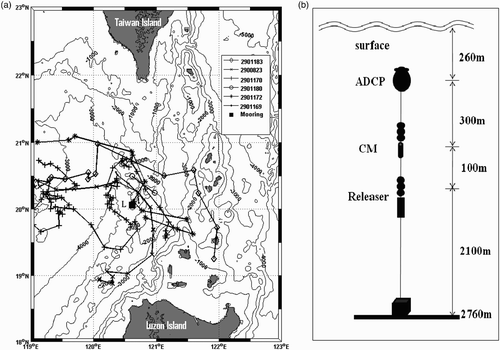
Using an isopycnal model, Simmons, Hallberg, and Arbic (Citation2004) found that 75% of the M2 global barotropic-to-baroclinic conversion occurred at 20 sites of abrupt topographical changes, which together accounted for less than 10% of the ocean floor. Hengchun Submarine Ridge in LS is an important site for M2 barotropic-to-baroclinic conversion. The 300 km long ridge lies almost perpendicular to the dominant M2 barotropic tidal currents. The ridge lies equatorward of 28.9° latitude; thus, non-linear interactions, such as parametric subharmonic instability (PSI) (McComas & Bretherton, Citation1977; Müller, Holloway, Henyey, & Pomphrey, Citation1986), can potentially transfer energy from M2 to M2/2 (defined as M1) without violating the internal wave requirement that f ≤ ω ≤ N, where ω is the wave frequency, N the buoyancy frequency, and the inertial frequency is f = 2Ωsinφ, where Ω is the earth's rotation vector, and φ is the latitude. Some non-linear interactions have been revealed from a site on the continental slope in the SCS, and the distinct subharmonic of M2 (M1) can be clearly distinguished from the lunar diurnal O1 and lunisolar diurnal K1 (Xie et al., Citation2008, Xie, Shang, van Haren, Chen, & Zhang, Citation2011). Non-linear waves and internal tides in the northern SCS mainly originate from LS (Buijsman, Kanarska, & McWilliams, Citation2010; Cai & Xie, Citation2010). However, the non-linear interactions between different frequency bands of internal waves in this area are rarely reported.
The main objective of this study is to investigate the general current system and the internal tidal characteristics in LS based on the analysis of moored current data and Argo profiler observations from 16 October 2008 to 5 July 2009. The possible non-linear interactions are examined, providing evidence of PSI in the LS area. The datasets are described in Section 2. Relevant results and analyses are discussed in Section 3 with conclusions in Section 4.
2 Field observations and data
Numerical models (Jan, Chern, Wang, & Chao, Citation2007; Niwa & Hibiya, Citation2004) and observations (Liao et al., Citation2010) have found that the strongest regions of M2 internal tide generation can be found along Hengchun Ridge. A mooring was deployed at 120°36.818′E, 20°03.828′N, where the water depth is 2760 m, during the cruises of the R/V Dong Fang Hong 2 on 16 October 2008, during the Argo 973 project (a). This mooring was recovered on 5 July 2009. The mooring was located west of the submarine Hengchun Ridge in LS, where internal waves have been observed by satellite and field studies (Du et al., Citation2008; Li, Farmer, Duda, & Ramp, Citation2009; Liu et al., Citation2006, Citation2008). An upward looking Acoustic Doppler Current Profiler (ADCP; 75 kHz RDI Workhorse) was mounted at 260 m depth. One current meter was deployed at 560 m depth to measure the mid-layer current, but it failed to record data (b). The moored ADCP recorded the current at 20-minute time intervals and range-gated them into 20 m bins. Pressure data recorded by the ADCP show that the instrument depth fluctuated several tens of metres at the semi-diurnal tidal frequency and occasionally as much as 100 m during spring tides. The data from ADCP bins 1 and 2 have multiple spikes because of the occasional presence of a pick-up buoy, whereas at the end of the observational range bin 12 had many outliers. They are rejected from further analysis because of their limited quality. The time-dependent vertical positions of the sensors were estimated from the pressure records. The range of high quality data is from −190 to −30 m after correcting for pressure. The current time series are treated as though the instrument depth is stable after correcting for these offsets. The measured current error is estimated at 1.6 cm s−1. Additional errors may be present in the upper bins during storms because of unresolved surface-wave orbital velocities. The time series instrument collected data from 16 October 2008 to 5 July 2009, which is a sufficiently long period to enable the separation of the three main diurnal harmonics (Q1, O1 and K1) and of the two main semi-diurnal harmonics (S2 and M2). Furthermore, the frequency spectra of the current time series were smoothed variably (see Section 3b). Therefore, the results of the spectral analysis must be interpreted as a mixture of frequencies.
The vertical profiles of temperature and salinity were collected from Argo profiler data in the vicinity of the mooring station during the mooring deployment period. The Argo data were provided by the China Argo Real-time Data Center (http://www.argo.org.cn/english/index.html). At 10-day intervals, the Argo floats rise to the surface over approximately a 6-hour period during which temperature and salinity measurements are taken. Satellites determine the position of the floats when they surface and receive the data transmitted by the floats. The floats then sink to drift at 2000 m depth until the cycle is repeated. Sampling positions and trajectories of Argo floats are shown in a, and the observational period of Argo profilers are listed in . Temperature and salinity are seasonally averaged to obtain a representative hydrographic structure and the average stratification for the area.
Table 1. The dates of Argo data used in this analysis.
3 Results and discussion
The stratification characteristics of LS are first analyzed using Argo data. The Wentzel-Kramers-Brillouin (WKB) approximation (Leaman & Sanford, Citation1975) is applied to normalize current data measured by the ADCP. The statistical analysis, wavelet analysis, spectral analysis and tidal analysis are carried out on observed velocity profiles.
a Hydrographic Background and General Description of the Observed Current
1 Stratification and Wentzel-Kramers-Brillouin scaling
The seasonal average buoyancy frequencies
Fig. 2 Vertical distribution of the Brunt-Väisälä frequency (N, cpd) calculated from Argo profiler data. The ranges of the ADCP observations are indicated by the double-headed arrow.
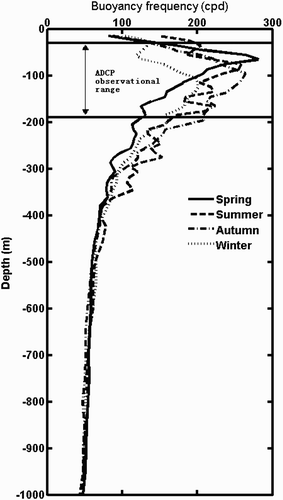
As a result of the variation of stratification with depth, horizontal velocity and energy density tend to be intensified at depths where stratification is strong, whereas isopycnal displacements are amplified in the deep water where stratification is weak. To minimize the complicating influence of variable stratification, the WKB approximation is used to normalize oceanic data with an equivalent constant stratification. The WKB-scaled horizontal velocity is given by
2 General description of the current system
The velocity time series for different months are similar in structure (figures not shown) and show three different temporal scales of motion: long period, tidal period and short period. The frequency spectra support this division (see Section 3a and Section 3b). The basic statistics of the observed velocity profiles, that is, profiles of the time mean, μ, and standard deviation, σ, of the horizontal and vertical velocities (u, υ, w) and the mean vertical gradient of the velocity, are shown in . Several general flow characteristics are apparent. First, the mean horizontal velocities, μu and μυ , suggest a tendency for a background flow in a northward direction. The along-ridge current is stronger than the cross-ridge current throughout the water column. The cross-ridge current changes its sign at about 80 m depth. The along-ridge current weakens and decreases linearly with depth, and the observed along-ridge current at the surface is three times faster than that at the bottom. The standard deviations of the horizontal velocities (i.e., σu and συ ) are greatest in the upper layer. Second, the average vertical gradients of μu are greatest above 110 m depth. On the other hand, the average vertical gradients of μu and μυ decrease linearly with depth below 110 m, which along with the correspondingly large σw is an indication of enhanced mixing. Finally, the mean vertical velocity, μw , is upward above a depth of 130 m and downward between the depths of 130 and 180 m. The vertical gradient of μw implies horizontally divergent flow from 70 to 150 m and horizontally convergent flow at depths below 150 m. The magnitude of the standard deviation, σw , is greater than that of the vertical flow velocity itself which has a maximum value at 30 m.
Fig. 3 Basic statistics of the observed velocity profiles. (a) Water column profiles of the time–mean horizontal velocity, μu (solid line) and μυ (dashed line). (b) Standard deviations of the horizontal velocity, σu (solid line) and συ (dashed line). (c) Mean vertical shear of the horizontal velocity. (d) Mean vertical velocity, μw . (e) Standard deviation of the vertical velocity, σw . (f) Mean vertical gradient of the vertical velocity.
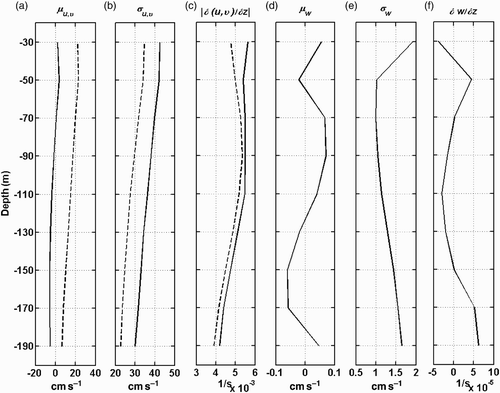
3 Barotropic velocity
Barotropic velocities were defined as the depth-mean of the horizontal velocity profiles obtained with the ADCP (i.e., <u>z , <υ>z ), and time series of barotropic velocities are shown in a and 4e, where u bot and υ bot denote cross- and along-ridge barotropic currents, respectively. Barotropic flow primarily consisted of a nearly circular mixed tide (0.25 ± 0.03 m s−1) superimposed on a weak along-ridge flow (0.11 ± 0.01 m s−1), where the range is the standard deviation. Dynamical analysis of non-stationary currents requires a method that can represent a signal as a function of both frequency and time. We employed continuous wavelet transforms (CWT) to examine the spectral content of the barotropic current, resulting in the contours of the wavelet power spectrum shown in . The Morlet wavelet function is adopted as the mother wavelet in our analysis, other wavelet bases (such as the “Mexican hat” and “Paul”) were tested and gave the same qualitative results. Scales for the CWT were chosen to resolve the major tidal frequencies with sufficient redundancy such that the wavelet transform preserves variance and the time series could be accurately reconstructed. The CWT analysis was performed in Fourier space following the methods outlined by Torrence and Compo (Citation1998).
Fig. 4 Barotropic currents. (a) 1 h averaged cross-ridge velocity component u bot. (b) Logarithm of the wavelet power spectrum for u bot. (c) Time-averaged wavelet power for u bot; the negative value is excluded for better visualization. (d) Scale-averaged wavelet power for u bot. (e) 1 h averaged along-ridge velocity component υ bot. (f) Logarithm of the wavelet power spectrum for υ bot; the negative value is excluded for better visualization. (g) Time-averaged wavelet power for υ bot. (h) Scale-averaged wavelet power for υ bot. In panels (b) and (f) the solid lines mark the major tidal (K1 is diurnal and M2 is semi-diurnal) and local inertial (f) periods. The solid curves on either side of the wavelet spectra indicate the "cone of influence" where edge effects become important.
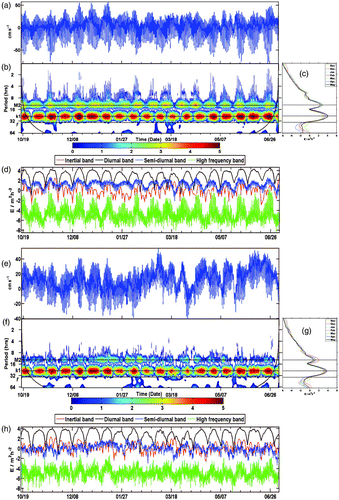
Broad peaks in wavelet power are seen in the inertial period to the 18-hour band, in both u bot and υ bot. A secondary peak area is present near the semi-diurnal tidal band. The spectral energy also shows a strong fortnightly spring-neap tide cycle. Large amplitude and high-frequency current oscillations persisted throughout the spring tide period. These events appear as vertical contours in wavelet power with peaks broadly distributed across the spectrum (b and 4f). The most striking feature is a dramatic shift in the along-ridge velocity between January and March. This should be related to swing of the strong Kuroshio.
The time-averaged wavelet power (c and 4g) was calculated for both the cross- and along-ridge components of the barotropic velocities. Time averages were calculated separately for a single month to highlight the difference in spectral power between these months. The results show that only the low-frequency band indicates some variance, and these low-frequency motions are related to mesoscale processes. To visualize the covariance between the different frequency band signals, scale-averaged wavelet powers (d and 4h) were calculated in the inertial frequency band (31–38 hours), diurnal (18–28 hours), semi-diurnal (8–16 hours) and high-frequency bands (<3 hours). The diurnal band shows smooth variance with a fortnightly spring-neap cycle, indicative of only an astronomical tide-generating force. However, the semi-diurnal band power exhibits high-frequency oscillations resulting from non-linear interactions. The high-frequency band power oscillates with the tidal cycle, showing high values for the spring tide. Near-inertial wave motions showing random variance may be due to changes in the wind forcing at the sea surface or due to random forcing.
4 Baroclinic velocities
presents the long-term mean vertical structure of the velocity field. At shorter time scales, the velocity variance and the vertical structure showed variability. The temporal and vertical variation of the two baroclinic velocity components, which were computed as u′(z, t) = u(z, t) − <u(t)>z , are shown in . Here we use u bc and υ bc to denote across- and along-ridge baroclinic currents, respectively. Although the dominant signal is diurnal with the greatest amplitude and regularity, a 12.4 h semi-diurnal signal and a fortnightly spring-neap tide cycle are also apparent. A distinct vertical modal structure is seen, and the particular vertical structure and direction of the vertical phase and energy propagation differs between months. The vertical velocity structure was similar to the harmonic M2 tide, and the semi-diurnal motion was concentrated mainly in the upper and lower halves of the observational range with slight changes where high-velocity cores were present. The spring-neap tidal cycle and long-term currents resulting from mesoscale eddies as well as seasonal and interannual variability may change the generation and propagation of the internal tides, leading to local variations in amplitude and phase, as illustrated in . As discussed earlier, mean along-ridge current velocities are faster than the mean cross-ridge current velocities. The weak velocity cores are present around 110 m depth. Baroclinic velocity averaged over a month exhibits the strong shear structure of the current. The velocity is in a northeastward direction in the layer above 110 m depth and is in the opposite direction below this depth during most months, except January and February, that is, the velocity is in a southeastward direction in the layer above about 110 m depth and in a northwestward direction below this depth in January and February, respectively.
Fig. 5 Cross-ridge (u) and along-ridge (υ) baroclinic velocity time series from ADCP measurements (left panel), and averaged baroclinic velocity over a month (right panel).
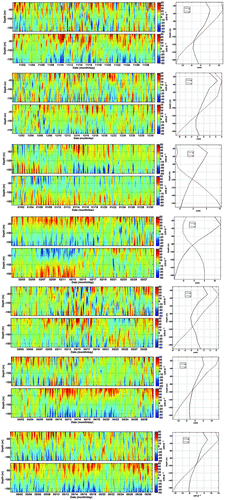
To highlight the vertical structure, the variance of the baroclinic velocity is determined by integrating the spectrum over the inertial, diurnal and semi-diurnal frequency bands (). These variances appear to depend on depth. The semi-diurnal frequency is the most energetic; it has a maximum near the surface and bottom of the observational range and a minimum in the middle of the water column; the cross-ridge velocity u bc is the most energetic. The magnitude of the variance of the near-inertial waveband increased slightly in the downward direction.
b Velocity Spectra Characteristics
Long-time measurements in other areas of the ocean have shown that the most intense internal waves are the internal tides; the tidal peaks in the power spectra of internal oscillations are one order of magnitude larger than the background (Vlasenko, Stashchuk, & Hutter, Citation2005). The highest peak is commonly seen in the lunar semi-diurnal period M2. If the latitude of the observation site is less than 30°, there is almost always a peak at the diurnal period K1. Inertial oscillations have been observed to be very energetic almost everywhere in the open ocean (Vlasenko et al., Citation2005). They are detected by the almost circular clockwise rotation in the northern hemisphere, with an inertial frequency f. The spectral features of internal waves have been emphasized in numerous works (Filonov & Lavín, Citation2003; van Haren, Citation2007; van Haren, Maas, & van Aken, Citation2002). In order to illustrate the characteristic contribution of tidal and other frequencies to the observed horizontal motion, rotary (clockwise P −(ω) and counter-clockwise P +(ω) spectra) and kinetic energy spectra (P KE(ω) = P −(ω) + P +(ω)) were calculated for the horizontal velocity time series (van Haren, Citation2003).
In our spectral analysis, variable smoothing is applied, with degrees of freedom (dof) ν = 4–30. The data are divided into two segments without further smoothing regarding some deterministic (e.g., tidal) motions rather than a stochastic realization, thus ν = 4 dof yields a bandwidth of 0.0022 cpd for the data record. Heavy smoothing (ν = 30) created such large bandwidths that the enhanced energy in tides and inertial bands merged. The kinetic energy spectra of the barotropic velocity (dashed line) and the observational depth-averaged kinetic energy spectra of baroclinic velocity (solid line) are shown in a. The observed kinetic energy spectra revealed that the dominant spectral lines are located at frequencies within the inertial–semi-diurnal tidal band, which are depicted as f, D 1, D 2 in . In a, the only components shown are those associated with the lunar D1 and D2 tidal constituents, but the nearly raw spectra also showed harmonics associated with the tidal constituents O1, Q1, S2, … (figure not shown). It is clear that the diurnal and semi-diurnal bands dominated the depth-averaged variance (dashed curve in a); the contribution of the higher tidal harmonic band is relatively small. There are no distinct peaks in the near-inertial frequency band in the spectral figure of barotropic tides. The diurnal peak is composed of O1 and K1 of equivalent energy, and relatively weak Q1. The semi-diurnal peak is mainly a combination of M2 and S2, with the M2 energy dominating the band. In addition to these fundamental inertial and tidal frequency bands, significant peaks are also found at some higher tidal harmonic bands (e.g., D3 and D4).
Fig. 7 (a) Kinetic energy spectra of barotropic velocity (dashed curve) and depth-averaged kinetic energy spectra of baroclinic velocity (solid curve) from ADCP current meter observations. The inclined lines show dependences of the slope with growth of frequency. (b) Clockwise (solid line) and counter-clockwise (dashed line) spectra of the horizontal velocity. Spectra were heavily smoothed (ν = 30 dof). The symbols f, D1, and D2 are inertial frequency, diurnal and semi-diurnal, respectively. D3, D4, D5 indicate higher tidal harmonic frequency.
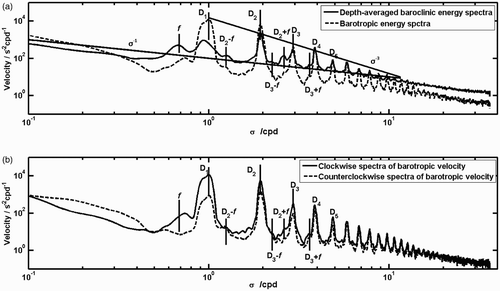
The solid curve in a describes the depth-averaged kinetic energy spectra of baroclinic velocity. Some differences can be seen between it and the kinetic energy spectra of the barotropic velocity. The largest peak occurs at the semi-diurnal frequency band D2, and the second at diurnal tidal frequencies. The third highest spectral peak in the internal wave band spectra is seen near the Coriolis frequency, f, and is indicative of near-inertial waves. Additional peaks were centred at sum-tidal-inertial interaction frequencies (such as M2 + f) and difference-interaction frequencies (such as M2 − f). The presence of spectral peaks at higher harmonics of the semi-diurnal tides and at linear combinations of these frequencies with the Coriolis frequency is not unique in the NSCS. Xie et al. (Citation2008) and Xie, Shang, & Chen (Citation2010) already reported the presence of such peaks in a spectrum derived from observations in the slope region of the NSCS. These are assumed to be caused by non-linear interactions, especially the advection of slower moving high-frequency waves by the dominant M2 internal tides. The spectral exponent in the observed baroclinic velocity is ω −α (1 < α < 3), as shown by the two straight lines in a. This is similar to the observations in the northeastern South China Sea, which demonstrated spectra with a power law of ω −2.3 with frequency (Xie, Shang, & Chen, 2010).
The rotary spectra of barotropic velocity provide additional information on these internal wave band peaks compared to the kinetic energy spectra (b). In the diurnal frequency band, the energy of the clockwise component spectrum is greater than that of the counter-clockwise component spectrum. On the other hand, the energies in the clockwise and counter-clockwise spectra are comparable for the semi-diurnal band. The difference between the rotary spectra is a measure of the polarization, for which Gonella (Citation1972) introduced the “rotary coefficient” (i.e., C R = (P −(ω) − P +(ω))/P KE(ω)). b shows the diurnal tide vector rotating clockwise with an ellipsoidal trajectory, but the semi-diurnal fluctuations of the velocity vector were more linear than ellipsoidal throughout the water column. These will be validated further in the harmonic analysis.
The kinetic energy and rotary spectra of baroclinic velocity throughout the observed water column exhibited vertical variability (figure not shown). Remarkably, the semi-diurnal tidal band is only dominant in the surface layer and the observed lower layer, and its energy is weak in the thermocline (near 100 m depth). On the other hand, the polarization of the flow in the semi-diurnal band is great over all observed depths, where the clockwise and counter-clockwise spectra are of the same magnitude (i.e., the semi-diurnal current indicates rectilinear flow). The largest diurnal peak is found at 150–190 m depth and the clockwise rotation component is dominant. The near-inertial frequency band is well marked throughout the water column and the largest peak appears at about 190 m. The clockwise spectrum at M2 − f is larger than the counter-clockwise spectrum; whereas the clockwise spectrum at M2 + f is smaller lower than the counter-clockwise spectrum. It can be interpreted according to the spectral property of linear internal waves examined by Fu (Citation1981), that is,
When A R >>1 dominance of the clockwise rotary near-inertial motion is implied.
c Evidence for Parametric Subharmonic Resonance
Non-linear interactions are able to transfer energy within the internal wave spectrum. The fundamental interaction is that of two plane waves with wave vectors k 1 and k 2, and frequencies ω(k 1) and ω(k 2) determined by the dispersion relation (Gill, Citation1982). The non-linear terms in the equations of motion [u(∂u/∂x)]etc., appear as
If Eq. (2) is satisfied, the interaction is resonant and the non-linear terms contribute to a freely propagating wave. For plane waves with phase θ = kx − ωt, Eq. (2) may be separated into the diagnostic resonance conditions (Phillips, Citation1977),
McComas and Bretherton (Citation1977) described three theoretical classes of resonant wave-triad interactions. One such triad is parametric subharmonic instability (PSI), so called because the energy of internal waves from low wavenumbers with frequency ω can be transferred to high wavenumbers with a frequency of 1/2ω through non-linear resonant interactions, that is, a wave to excite daughter waves with higher wavenumbers and half the frequency. The resonant condition for PSI satisfies ω 2 ≈ ω 3 ≈ ω 1/2, k 2 ≈ k 3 >> k 1. Many numerical experiments (Gerkema, Staquet, & Bouruet-Aubertot, Citation2006; Hibiya, Nagasawa, & Niwa, Citation2002; MacKinnon & Winters, Citation2005) as well as observations (Rainville & Pinkel, Citation2006; Xie et al., Citation2011) have found that equatorward of 28.9° significant energy may be transferred to M1 (M2/2) from M2 by such non-linear interactions.
1 Frequency spectra
Our interest was limited to high-energy low-frequency signals (inertial to semi-diurnal). The time series is long enough to distinguish between motion at the diurnal tidal frequency and the M1 (M2/2) frequency. presents the kinetic energy spectra P KE(ω), clockwise spectra P −(ω) and counter-clockwise spectra P +(ω) of the current velocity with weak smoothing (dof ν = 4). The dominant tidal constituents and local inertial frequencies are indicated in the figure. Several important features can be seen in . The strongest signal occurred at M2; the energy of the semi-diurnal fluctuations is one order of magnitude larger than for the other tidal components in the entire water column. In addition, most of the energy is concentrated in the local frequency band from f to near-diurnal frequencies, shown as dashed lines labeled Q1, O1, M1 and K1. Note that peaks in the diurnal band also appear at some non-tidal frequencies (e.g., M1 = M2/2).
Fig. 8 (a) Profiles of baroclinic kinetic energy spectra (units are cm2 s−2 cpd−1) of baroclinic velocity (P KE). (b) Clockwise spectra (P −). (c) Counter-clockwise spectra (P +). Spectra were weakly smoothed (ν = 4 dof). All spectra are logarithmic values.
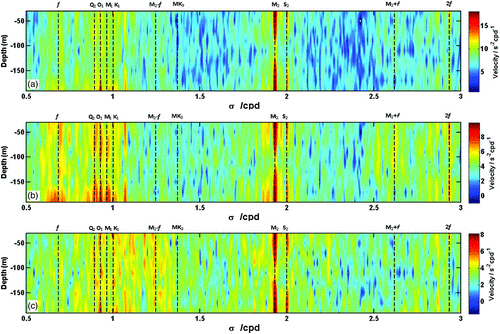
shows shear spectra at the observed depth. The stronger signal occurred at near-diurnal frequencies, in spite of the strongest peaks appearing at the semi-diurnal frequencies, similar to the kinetic energy spectra. The spectra in each depth bin are shown in b. A diurnal signal in the shear is also obvious throughout most of the observed water column. The diurnal band is enhanced by a resonant interaction with M1 (M2/2), and the strongest signal at subharmonic M1 (M2/2) appears from surface to 110 m depth and between 150 and 190 m depth. The bicoherence analysis in the next section will also show that the M2/2 waves non-linearly coupled to the dominant M2 internal tide exist for similar depth ranges. Non-linear interactions are more likely to occur in the regions where internal tidal beams intensify displacement and energy density.
2 Bispectrum and bicoherence
In the previous section, we demonstrated that M1 (M2/2) waves existed in the velocity and shear fields in LS, but linear spectral analysis assumes that the energy at each frequency is independent and is of limited use for determining interactions between waves. Higher-order spectral analysis can be used to distinguish between non-linearly coupled waves. Bispectra (Elgar & Guza, Citation1988) are a measure of consistent phase relationships between triads of waves that satisfy frequency and/or wavenumber resonance conditions, Eq. (2). Here we will briefly review the bispectrum method; further details can be found in Elgar and Guza (Citation1988). For a continuous real time-series u(t) of a zero-mean perturbation quantity, the Fourier transform is
Elgar and Guza (Citation1988) calculated the significance levels for the bicoherence method using the Monte Carlo theory and found that data are significant at the 90% confidence level with a bicoherence above (4.6/n dof)1/2, where the number of degrees of freedom (n dof) is twice the number of independent realizations. Bispectral analysis was used in earlier studies to examine non-linear energy transfers within the oceanic internal wave field (Furue, Citation2003; McComas & Briscoe, Citation1980; Niwa & Hibiya, Citation1997). For PSI, the bicoherence function b is expected to peak at frequency pairs b(ω/2, ω/2) or b(ω/2, −ω) where the third member of the triad identified by the bicoherence is ω = −(ω/2, ω/2) or ω/2 = −(ω/2, −ω). To compute bicoherence, data are divided into 50% overlapping, 2-day windows.
gives the average of the bicoherence of the cross-ridge (u) and along-ridge (υ) velocity components from all time intervals and all observation bins. The bicoherence spectrum is symmetric (Rao & Gabr, Citation1984), and a non-redundant region for the bicoherence is the triangular area indicated by the white lines in . Therefore we will only discuss the upper right quadrant of the bicoherence plots. The largest bicoherence value appears at [1.93, 1.93] cpd in u velocity components, suggesting that superharmonic occurring by non-linear interaction of semi-diurnal waves, namely M2 + M2 = M4, rather than by Doppler shifting. Another two large bicoherence values appear at frequency bin [1.93 3.86] cpd (M2 + M4 = M6) and frequency bin [3.86 3.86] cpd (M4 + M4 = M8), respectively, indicating strong non-linear interactions between tidal harmonics rather than resonant interactions. Xing and Davies (Citation2002) performed a theoretical analysis on these types of forced non-resonant, non-linear interactions, which are primarily caused by large non-linear advection terms (u · ▿u) from internal wave momentum equations. However, significant peaks at these frequency bins cannot be found for the υ velocity components. In fact, the non-linear interaction exists in a limited range of vertical depths (see ) as follows.
Fig. 10 (a) Average bicoherence of the cross-ridge velocities using all the data in the observational range. (b) As in the left panel but for the along-ridge velocities.
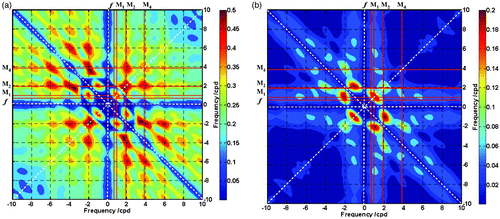
Fig. 11 (a) Bicoherence values in the different frequency bins plotted as a function of depth for cross-ridge velocities. The vertical solid line gives the 90% significance level. (b) As in (a) but for the along-ridge velocities.

Significant bicoherence also occurs at [0.97, 0.97] cpd (M1, M1) for u and υ velocity components, which is further evidence of the occurrence of semi-diurnal internal tidal PSI. In addition, the subharmonic resonant non-linear interaction depends on depth. Bicoherence analysis can be repeated on individual depth bins. gives the bicoherence values with depth for three frequency bins ([0.97, 0.97] cpd, [1.93, 1.93] cpd and [1.93, 3.86] cpd) for the u and υ velocity components. The bicoherence at [0.97, 0.97] cpd, namely PSI occurrence, is significant at the 90% confidence level for most of the observed depth range for u velocity components, and the significant bicoherence values appear between 30 and 110 m. The bicoherence of υ velocity components is significant at the 90% confidence level between 50 and 110 m (). This narrow depth range corresponds to the location of the energy transfer from M2 to M2⁄2 and an M2 characteristic occurred in the part of the water column we sampled.
d Tidal Analysis
We now focus on the primary analysis of tidal variability at the mooring station. Because of the strong contribution of tides to the current variance in LS, the profiler time series (u, υ) were digitally filtered into three bands, the high frequency band, the tidal band and the low-frequency or mesoscale band for separating tidal period oscillations and low frequency motions. The data were first processed by a low-pass Lanczos filter with a half-power point at 36 hours. The low-pass filtered data were then subtracted from the original time series to remove the low-frequency content. The intermediate time series were subsequently filtered again in frequency space to separate the high frequency signal from the tidal and inertial motions. The resulting time series thus spanned periods greater than 36 h, 36–3 h, 3 h, and less than 3 h. In this paper, little attention is given to low–frequency and high–frequency motions, and we will discuss low–frequency motion in detail in future work. Of greater interest are the strong tidal-band oscillations in the following analysis.
1 Barotropic tidal current
Barotropic tidal velocities were computed as the depth mean of the tidal-band horizontal-velocity profiles described previously (‹u›z, ‹υ›z). The current magnitudes in the tidal band ranged from 0.04 to 157 cm s−1 with a mean value of 32.6 cm s−1 and a standard deviation of 2.6 cm s−1, whereas the mean low-frequency currents had magnitudes ranging from 0.07 to 99 cm s−1 and a mean value of 24.1 cm s−1 and a standard deviation of 3.8 cm s−1.
Harmonic tidal analysis was carried out on the barotropic tidal currents using the MATLAB T_TIDE program (Pawlowicz, Beardsley, & Lentz, Citation2002). T_TIDE was run with the linear trend removal and the normal Rayleigh criterion of 1.0. The tidal series includes all the constituents with a signal-to-noise ratio (SNR) ≥ 2, where the SNR was computed on the basis of the square of the ratio of the amplitude to the amplitude error (Pawlowicz, Beardsley, & Lentz, Citation2002). The procedure accounts for 56% of the variance for the westward component. The series is a mix of tides with different periodicity, with diurnal tides being dominant and the semi-diurnal tidal speeds being approximately 82% of the diurnal tide speeds.
The principal tidal ellipse parameters are presented in . Here, the phase is the Greenwich phase, which denotes the lag of the tide from the tide-generating force, and the inclination gives the major axis direction measured counter-clockwise from east. A negative minor axis indicates a clockwise velocity rotation. The dominant tidal currents are the two primary diurnal constituents O1 and K1 and the two semi-diurnal constituents M2 and S2 () with amplitudes of 15.03, 21.69, 21.69 and 7.63 cm s−1, respectively, which are almost twice those at the northern station (120°30.332′E, 20°59.961′N) observed from 25 April to 26 September 2008 (Liao et al., Citation2010). The diurnal tidal currents are the strongest. The ratio of the O1/K1 semi-major axis lengths of about 0.70 also explains the diurnal inequality and spring-neap cycle. The O1 and K1 tidal constituents have similar ellipse characteristics; both diurnal velocity vectors rotate clockwise with time. The major axes appear to be oriented around 19°, nearly perpendicular to the local isobaths and aligning cross-shelf in the NSCS (). The ratios of minor to major axis lengths are 0.6 and 0.57, respectively, indicating comparable cross-shelf and along-shelf components (also see below).
Table 2. Tidal ellipse parameters of dominant tidal components (SNR > 5) at the observation site.
Fig. 12 Tidal current ellipses of primary components, decomposed into the barotropic (shown at zero depth) and baroclinic components over the water column. Ellipses are centred at the measurement depths. The shading of the ellipses indicates clockwise vector rotation; the line from the ellipse centre shows the velocity direction at the zero phase.
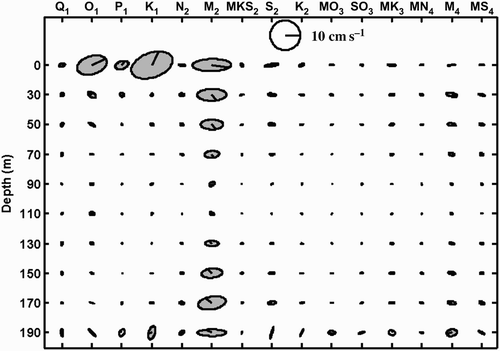
The dominant semi-diurnal constituent is M2, with current amplitude roughly three times larger than that of S2. However, both M2 and S2 have a major axis aligned around 5°, oriented roughly perpendicular to the local isobaths and slope of the NSCS. The ratio of minor to major axis lengths is very small, indicating that the cross-ridge component exceeds the along-isobath component by at least 70%. The cross-ridge alignment of the ellipses is important for internal tide generation, which is most effective for a large flux of water up and down the topographic slope. Both semi-diurnal velocity vectors rotate clockwise with time.
2 Baroclinic tidal currents
Baroclinic tidal velocity parameters can be found as functions of depth in each ADCP record. For each current layer, tidal analysis is first carried out on the entire residual time series at each depth, computed as the total tidal-band current minus the depth-averaged value (barotropic tidal current). This separates the baroclinic tidal phases and ellipse geometries from their barotropic counterparts. Although barotropic waves travel much faster than phases of the internal waves, they have current ellipses of the same magnitude as the baroclinic waves; thus, it is necessary to remove them. Most of the baroclinic variance was explained by two semi-diurnal tides (M2 and S2). From 40% to 80% of the time series variance at various depths was explained by fitting in the 30–70 m and 150–190 m depth water columns, but 80% to 90% was explained at 90–130 m depth. The other tidal current ellipses are very small, indicating lower baroclinic velocities.
shows the internal tidal ellipses of primary components at different depths. Barotropic tides are different; the diurnal internal tides are weak compared with the semi-diurnal internal tides. The O1 baroclinic velocities are highest in the diurnal band, with currents of about 5 cm s−1 at the surface, 2 cm s−1 at 90 m and 190 m and 30 cm s−1 at 130 m. In addition, the phases of both diurnal tides decrease with depth and reach minimum between 70 and 110 m depth, then increase with depth. Their tidal ellipses show some clockwise rotation over the entire depth. The ratios of minor to major axis lengths vary sharply from the surface to 190 m for O1 and K1. The inclination of the K1 tide hovers around 20°, and it is similar to the inclination of the K1 diurnal barotropic tidal component. The inclination of O1 decreases monotonically from 30 to 190 m depth.
The structures of the current ellipses of the two dominant semi-diurnal constituents are similar, but the M2 tidal current is much stronger (). The M2 baroclinic velocity is greater than 15 cm s−1 near the surface; gradually decreasing with depth to a minimum of 3 cm s−1 at 110 m depth, then intensifying with depth. The velocity vectors for the M2 and S2 tides rotate clockwise throughout the observed water column. In addition, the ratio of minor to major axis lengths also varies with depth. The major axis for M2 and S2 is crossed over a submarine ridge throughout the observed depth, consistent with the barotropic tidal component.
The other tidal current ellipses (i.e., those of Q1, P1, N2, K2, MO3, SO3, MK3, M4 and MS4) are very small, indicating lower baroclinic velocities, but their amplitudes are comparable to the velocity of the S2 tide at the surface. In addition, these main tidal ellipses show distinct baroclinic structure, especially the M2 tide, which is similar to the first mode ().
3 Comparison with polarization relations for a linear internal wave
Using a right-hand Cartesian coordinate system with the z axis directed upward, the velocity components u, υ, and w and perturbation pressure p′ all have the form exp[i(kx + ly + mz – ωt)]. For plane progressive waves, the polarization relations for the velocity components (u, υ, w) are expressed as (Gill, Citation1982)
Fig. 13 Parameters of O1 and K1 as functions of depth. (a) Major axis; (b) minor axis, where negative amplitudes indicate clockwise current rotation. (c) Inclination counter-clockwise from east. (d) Phase with respect to astronomical forcing. Increasing phase with depth indicates that the tide is increasingly delayed with depth, and thus the phase velocity is downward. (e) The absolute value of the ratio of major to minor axes. The vertical solid line shows the expected ratio f/ω k1 for internal waves of the (diurnal tidal) frequency. (f) Variance of each fitted tidal constituent (O1 and K1). Values for the barotropic O1 (dotted line) and K1 (dashed line) ellipse parameters are indicated.
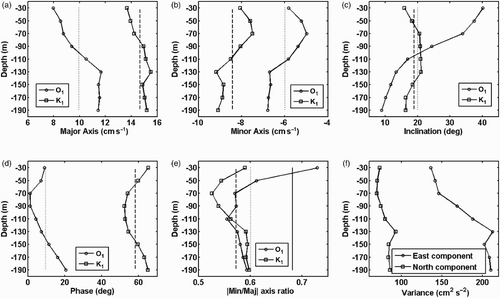
Vertical profiles of ellipse parameters and variances for the two dominant diurnal baroclinic constituents are shown in . Values for the barotropic O1 (dotted line) and K1 (dashed line) ellipse parameters are indicated in the same figures. The dominant diurnal constituent throughout the water column was K1, with a maximum amplitude near 100 m depth (). The amplitude of O1 is only half that of K1, but its vertical structure is similar to K1. The K1 inclinations vary around a mean of roughly 20° (panel (c)), and the O1 inclinations decrease with depth from 40° to 10°. The inclinations are aligned with the horizontal wavenumber (propagation direction) of a linear internal wave. Therefore, these inclinations indicate diurnal wave propagation to the east-northeast (or west-southwest). The Greenwich phase (panel (d)) tends to decrease with depth in the upper observed water column and increase with depth in the lower parts of the observed water column. From (e), it can be seen that the ratios of the minor to major axes are different from the expected ratio of f/ω K1 because the inclinations deviate from 0°.
Parameters for the two semi-diurnal constituents are shown in . The description of the data is the same as for except for the M2 and S2 tides. The currents for the M2 tide decrease gradually with depth in the observed water column, reaching a minimum velocity at 190 m depth, and the S2 currents are nearly stable in amplitude. The semi-diurnal waves propagate to the west, as their inclinations are in the vicinity of 10° in the observed water column. There is also an obvious phase jump around 60 m and 160 m for the M2 tide, In the layer from 50 to 150 m, the Greenwich phase decreases with depth, which is consistent with an internal wave having an upward phase velocity and downward internal wave energy propagation (Gill, Citation1982). The minor-to-major axis ratios are close to the expected value f/ω M2 in the layer from 30 to 150 m, which differs from the diurnal case. However, the phases of S2 are stable and around 30°.
4 Summary and conclusions
This study describes the characteristics of internal tidal currents in LS from observed currents. When barotropic tides pass through LS, baroclinic tidal modes can be produced by the barrier effect caused by the Hengchun Submarine Ridge (see ). This analysis confirmed that the diurnal and semi-diurnal internal tidal currents explain much of the total current, and the semi-diurnal baroclinic currents are prominent in the area. The main observational results of this analysis are summarized in the following.
| 1. | The mean horizontal velocity suggests that the along-ridge current has a larger mean but smaller variance throughout the water column. Strong mixing occurs at 110 m depth. The barotropic flow was a primarily circular mixed tide. The diurnal band showed smooth variance with a fortnightly spring-neap cycle, indicative of the tide-generating force being only astronomical. The semi-diurnal band, however, exhibited a high-frequency oscillation as a result of non-linear interactions. The power at the high-frequency band varies with the spring-neap cycle. The near-inertial wave motions show irregular variance that may be caused by changes in the wind forcing at the sea surface or by random forcing. Baroclinc velocities exhibit strong vertical shear structure, with most of the baroclinc kinetic energy concentrated in the upper and lower half of the observational depth. The observed large changes in amplitude of the baroclinic velocity and the limited vertical extent of the high-velocity cores may be interpreted as passing internal wave beams. | ||||
| 2. | Observed baroclinic kinetic energy spectra revealed that most of the energy is concentrated at localized frequencies within the inertial–semi-diurnal tidal band. The largest peak occurs in the semi-diurnal frequency band D2, and additional peaks were centred at tidal-inertial interaction frequencies (such as M2 + f) and difference-interaction frequencies (such as M2 − f), as well as the inertial frequency in the clockwise spectra. The spectral exponent of the observed baroclinic velocity is ω −α (1 < α < 3). The diurnal tidal vector rotated clockwise with an ellipsoidal trajectory, but the semi-diurnal fluctuations of the velocity vector were more linear than ellipsoidal throughout the water column. | ||||
| 3. | Strong non-linear interactions among internal waves exist, with the semi-diurnal component (M2) playing the key role in these interactions. The evidence of PSI influence can be seen from velocity spectra and shear spectra. The distinct subharmonic of the M2 (M2/2) spectral peak has been distinguished from other diurnal frequencies such as Q1, O1 and K1. The strongest signal at subharmonic M1 (M2/2) occurs in the surface layer and at the bottom of the observational range. Applying bicoherence analysis further demonstrates strong non-linear interactions among dominant internal tidal waves. The M1 (M2/2) wave is consistent with being coupled non-linearly to the dominant M2 internal tide. Analysis of bicoherence spectra also shows that higher tidal harmonics were derived from strongly forced non-linear interactions, which exist in a limited range of vertical depths. | ||||
| 4. | The polarization relations from linear internal wave solutions were used to diagnose observational internal tidal motions. The diurnal waves propagate to the east-northeast, and the semi-diurnal–diurnal waves propagate to the west. In the case of diurnal tides, the ratios of minor to major axes are different from the expected ratio of f/ω K1 because the inclinations deviate from 0°; while the minor to major axis ratio is close to the expected value f/ω M2 from 30 m to 150 m in the case of semi-diurnal tides. The M2 tide has an upward phase velocity and downward internal wave energy propagation in the layer from 50 to 150 m. | ||||
One limitation of this study is that the data were collected at only one mooring station over a limited depth. Future modelling of non-linear interactions is also required to explain our observations further. It is possible that other source regions play a role in generating internal waves. Many possible source regions and generation mechanisms of internal waves have been proposed (Cai, Long, & Gan, Citation2002; Lien et al., Citation2005; Niwa, and Hibiya, 2004; Zheng, Susanto, Ho, Song, & Xu, Citation2007). Internal tide generation and non-linear interactions are a three-dimensional problem varying with time, and further analyses of these data with numerical models may uncover more details of the observed baroclinic tidal waves. More observations are also required to investigate further the generation and non-linear interaction of internal waves in the area.
Acknowledgements
The mooring was deployed and recovered by the vessel R/V Dong Fang Hong 2 from the Ocean University of China. The highly competent work of the captain and crew is greatly appreciated. This study was supported by the National Basic Research Program of China (Nos. 2007CB816003, 2011CB403503, 2012CB955601) and grants from the scientific research fund of the Second Institute of Oceanography, SOA (Nos. JG1009 and JT1006). Finally, three anonymous reviewers made very valuable comments and suggestions, which were extremely helpful in the revision of our manuscript. The authors are greatly indebted to them for their detailed and careful comments and help.
References
- Buijsman , M. C. , Kanarska , Y. and McWilliams , J. C. 2010 . On the generation and evolution of nonlinear internal waves in the South China Sea . Journal of Geophysical Research , 115 : C02012 doi:10.1029/2009JC005275
- Cai , S. Q. , Gan , Z. J. and Long , X. M. 2002 . Some characteristics and evolution of the internal soliton in the northern South China Sea . Chinese Science Bulletin , 47 : 21 – 27 . (doi:10.1360/02tb9004)
- Cai , S. Q. , Long , X. M. and Gan , Z. J. 2002 . A numerical study of the generation and propagation of internal solitary waves in the Luzon Strait . Oceanologica Acta , 25 : 51 – 60 . (doi:10.1016/S0399-1784(02)01181-7)
- Cai , S. and Xie , J. 2010 . A propagation model for the internal solitary waves in the northern South China Sea . Journal of Geophysical Research , 115 : C12074 doi:10.1029/2010JC006341
- Du , T. , Tseng , Y. H. and Yan , X. H. 2008 . Impacts of tidal currents and Kuroshio intrusion on the generation of nonlinear internal waves in Luzon Strait . Journal of Geophysical Research , 113 : C08015 doi:10.1029/2007JC004294
- Duda , T. F. , Lynch , J. F. , Irish , J. D. , Beardsley , R. C. , Ramp , S. R. , Chiu , C.-S. , Tang , T. Y. and Yang , Y. J. 2004 . Internal tide and nonlinear internal wave behavior at the continental slope in the northern South China Sea . IEEE Journal of Oceanic Engineering , 29 : 1105 – 1130 . (doi:10.1109/JOE.2004.836998)
- Elgar , S. and Guza , R. T. 1988 . Statistics of bicoherence . IEEE Transactions on Acoustics, Speech, and Signal Processing , 36 : 1667 – 1668 . (doi:10.1109/29.7555)
- Fang , G. , Kwok , Y. K. , Yu , K. and Zhu , Y. H. 1999 . Numerical simulation of principal tidal constituents in the South China Sea, Gulf of Tonkin and Gulf of Thailand . Continental Shelf Research , 19 : 845 – 869 . (doi:10.1016/S0278-4343(99)00002-3)
- Filonov , A. E. and Lavín , M. F. 2003 . Internal tides in the northern Gulf of California . Journal of Geophyiscal Research , 108 ( C5 ) : 3151 doi:10.1029/2002JC001460
- Fu , L.-L. 1981 . Observations and models of inertial waves in the deep ocean . Reviews of Geophysics and Space Physics , 19 : 141 – 170 . (doi:10.1029/RG019i001p00141)
- Furue , R. 2003 . Energy transfer within the small-scale oceanic internal wave spectrum . Journal of Physical Oceanography , 33 : 267 – 282 . (doi:10.1175/1520-0485(2003)033<0267:ETWTSS>2.0.CO;2)
- Gerkema , T. , Staquet , C. and Bouruet-Aubertot , P. 2006 . Decay of semi-diurnal internal-tide beams due to subharmonic resonance . Geophysical Research Letters , 33 : L08604 doi:10.1029/2005GL025105
- Gill , A. E. 1982 . Atmosphere-ocean dynamics , 247 – 315 . New York : Academic Press .
- Gonella , J. 1972 . A rotary-component method for analyzing meteorological and oceanographic vector time series . Deep-Sea Research , 19 : 833 – 846 .
- Guo , P. , Fang , W. D. , Gan , Z. J. , Chen , R. Y. and Long , X. M. 2006 . Internal tide characteristics over northern South China Sea continental slope . Chinese Science Bulletin , 51 ( Supp. II ) : 17 – 25 . doi:10.1007/s11434-006-9017
- van Haren , H. 2003 . On the polarization of oscillatory currents in the Bay of Biscay . Journal of Geophysical Research , 108 ( C9 ) : 3290 doi:10.1029/2002JC001736
- van Haren , H. 2007 . Shear at the critical diurnal latitude . Geophysical Research Letters , 34 : L06601 doi:10.1029/2006GL028716
- van Haren , H. , Maas , L. and van Aken , H. 2002 . On the nature of internal wave spectra near a continental slope . Geophysical Research Letters , 29 ( 12 ) : 1615 doi:10.1029/2001GL014341
- Hibiya , T. , Nagasawa , M. and Niwa , Y. 2002 . Nonlinear energy transfer within the oceanic internal wave spectrum at mid and high latitudes . Journal of Geophysical Research , 107 ( C11 ) : 3207 doi:10.1029/2001JC001210
- Hsu , M. K. and Liu , A. K. 2000 . Nonlinear internal waves in the South China Sea . Canadian Journal of Remote Sensing , 26 : 72 – 81 .
- Jan , S. , Chern , C. S. , Wang , J. and Chao , H. Y. 2007 . Generation of diurnal K1 internal tide in the Luzon Strait and its influence on surface tide in the South China Sea . Journal of Geophysical Research , 112 : C06019 doi: 10.1029/2006JC004003
- Leaman , K. D. and Sanford , T. B. 1975 . Vertical energy propagation of inertial waves: A vector spectral analysis of velocity profiles . Journal of Geophysical Research , 80 ( 15 ) : 1975 – 1978 . (doi:10.1029/JC080i015p01975)
- Li , Q. , Farmer , D. M. , Duda , T. F. and Ramp , S. 2009 . Acoustical measurement of nonlinear internal waves using the inverted echo sounder . Journal of Atmospheric and Oceanic Technology , 26 : 2228 – 2242 . (doi:10.1175/2009JTECHO652.1)
- Liao , G. H. , Yuan , Y. C. , Arata , K. , Yang , C. H. , Chen , H. , Taniguchi , N. , Gohda , N. and Minamidate , M. 2010 . Analysis of internal tidal characteristics in the layer above 450 m from acoustic Doppler current profiler observations in the Luzon Strait . Science in China, Series D: Earth Sciences , 54 ( 7 ) doi:10.1007/s11430-010-4102-0
- Lien , R.-C. , Tang , T. Y. , Chang , M. H. and D'Asaro , E. A. 2005 . Energy of nonlinear internal waves in the South China Sea . Geophysical Research Letters , 32 : L05615 doi:10.1029/2004GL022012
- Liu , C.-T. , Pinkel , R. , Klymak , J. , Hsu , M.-K. , Chen , H.-W. and Villanoy , C. 2006 . Nonlinear internal waves from the Luzon Strait . Eos, Transactions, American Geophysical Union , 87 ( 42 ) : 449 doi:10.1029/2006EO420002
- Liu , C. T. , Yang , Y. , Wang , D. W. , Chao , Y. H. , Chiou , Y. J. and Lee , C. W. 2008 . “ Generation of nonlinear internal waves in Luzon Strait ” . In Satellite remote sensing of South China Sea , Edited by: Liu , A. K. , Ho , C. R. Liu , C. T. 25 – 43 . Taipei , , Taiwan : Tingmao Publish Company .
- MacKinnon , J. A. and Winters , K. B. 2005 . Subtropical catastrophe: Significant loss of low-mode tidal energy at 28.9° . Geophysical Research Letters , 32 : L15605 doi:10.1029/2005GL023376
- McComas , C. H. and Bretherton , F. P. 1977 . Resonant interaction of oceanic internal waves . Journal of Geophysical Research , 82 ( 9 ) : 1397 – 1412 . doi:10.1029/JC082i009p01397
- McComas , C. H. and Briscoe , M. G. 1980 . Bispectra of internal waves . Journal of Fluid Mechanics , 97 : 205 – 213 . (doi:10.1017/S0022112080002510)
- Müller , P. , Holloway , G. , Henyey , F. and Pomphrey , N. 1986 . Nonlinear interactions among internal gravity waves . Reviews of Geophysics , 24 ( 3 ) : 493 – 536 . doi:10.1029/RG024i003p00493
- Niwa , Y. and Hibiya , T. 1997 . Nonlinear processes of energy transfer from traveling hurricanes to the deep ocean internal wave field . Journal of Geophysical Research , 102 ( C6 ) : 12469 – 12477 . doi:10.1029/97JC00588
- Niwa , Y. and Hibiya , T. 2004 . Three-dimensional numerical simulation of M2 internal tides in the East China Sea . Journal of Geophysical Research , 109 : C04027 doi: 10.1029/2003JC001923
- Pawlowicz , R. , Beardsley , R. and Lentz , S. 2002 . Classical tidal harmonic analysis including error estimates in MATLAB using T_TIDE . Computational Geosciences , 28 : 929 – 937 . (doi:10.1016/S0098-3004(02)00013-4)
- Phillips , O. M. 1977 . The dynamics of the upper ocean , 2 , Cambridge : Cambridge University Press .
- Rainville , L. and Pinkel , R. 2006 . Baroclinic energy flux at the Hawaiian Ridge: Observations from the R/P FLIP . Journal of Physical Oceanography , 36 : 1104 – 1122 . (doi:10.1175/JPO2882.1)
- Ramp , S. R. , Tang , T. Y. , Duda , T. F. , Lynch , J. F. , Liu , A. K. , Chiu , C.-S. , Bahr , F. , Kim , H.-R. and Yang , Y. J. 2004 . Internal solitons in the northeastern South China Sea, part I: Sources and deep water propagation . IEEE Journal of Oceanic Engineering , 29 : 1157 – 1181 . (doi:10.1109/JOE.2004.840839)
- Rao , S. T. and Gabr , M. 1984 . An introduction to bispectral analysis and bilinear time-series models , 42 – 43 . New York : Springer-Verlag .
- Simmons , H. L. , Hallberg , R. W. and Arbic , B. K. 2004 . Internal wave generation in a global baroclinic tide model . Deep-Sea Research II , 51 : 3043 – 3068 . (doi:10.1016/j.dsr2.2004.09.015)
- Torrence , C. and Compo , G. P. 1998 . A practical guide to wavelet analysis . Bulletin of the American Meteorological Society , 79 ( 1 ) : 61 – 78 . (doi:10.1175/1520-0477(1998)079<0061:APGTWA>2.0.CO;2)
- Vlasenko , V. I. , Stashchuk , N. and Hutter , K. 2005 . Baroclinic tides: Theoretical modeling and observational evidence , Cambridge , , UK : Cambridge University Press .
- Xie , X.-H. , Chen , G.-Y. , Shang , X.-D. and Fang , W.-D. 2008 . Evolution of the semidiurnal (M 2) internal tide on the continental slope of the northern South China Sea . Geophysical Research Letters , 35 : L13604 doi:10.1029/2008GL034179
- Xie , X.-H. , Shang , X.-D. and Chen , G.-Y. 2010 . Nonlinear interactions among internal tidal waves in the northeastern South China Sea . Chinese Journal of Oceanology and Limnolnology , 28 ( 5 ) : 996 – 1001 . doi:10.1007/s00343-010-9064-8
- Xie , X.-H. , Shang , X.-D. , van Haren , H. , Chen , G.-Y. and Zhang , Y.-Z. 2011 . Observations of parametric subharmonic instability-induced near-inertial waves equatorward of the critical diurnal latitude . Geophysical Research Letters , 38 : L05603 doi:10.1029/2010GL046521
- Xing , J. and Davies , A. M. 2002 . Processes influencing the non-linear interaction between inertial oscillations, near inertial internal waves and internal tides . Geophysical Research Letters , 29 ( 5 ) : 1067 doi:10.1029/2001GL014199
- Yanagi , T. and Takao , T. 1998 . A numerical simulation of tides and tidal currents in the South China Sea . Acta Oceanographica Taiwanica , 37 : 17 – 29 .
- Yang , Y. J. , Tang , T. Y. , Chang , M. H. , Liu , A. K. , Hsu , M.-K. and Ramp , S. R. 2004 . Solitons northeast of TungSha Island during the ASIAEX pilot studies . IEEE Journal of Oceanic Engineering , 29 : 1182 – 1199 . (doi:10.1109/JOE.2004.841424)
- Zhao , Z. , Klemas , V. , Zheng , Q. and Yan , X.-H. 2004 . Remote sensing evidence for baroclinic tide origin of internal solitary waves in the northeastern South China Sea . Geophysical Research Letters , 31 : L06302 doi: 10.1029/2003GL019077
- Zheng , Q. , Susanto , R. D. , Ho , C.-R. , Song , Y. T. and Xu , Q. 2007 . Statistical and dynamical analyses of generation mechanisms of solitary internal waves in the northern South China Sea . Journal of Geophysical Research , 112 : C03021 doi: 10.1029/2006JC003551
